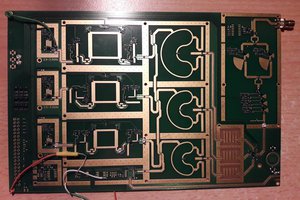I worked on this project at work in my spare time. My supervisor gave me permission to share it here.
I wanted some experience designing antennas, so I started with the simplest one, a patch antenna. There were some initial goals:
- Since I was doing this at work, I designed it for the 2.4 GHz ISM band which is what our proprietary wireless protocol uses
- Use a PCB as the only component, since they're cheap and easy to design
- Transmit 90% of the input energy. (S11 ≤ -10 dB)
- I'm ignoring antenna losses for now since I don't know of a way to measure them without an antenna chamber.
- Input impedance of 50 Ω
Design
I found some design equations in the textbook Antenna Theory: Analysis and Design 3rd Edition, pp 816-820, equations 14-1 to 14-7. I created a spreadsheet titled Patch Antenna Calculator to calculate the equations, which yielded the following results:
| INPUTS | |
| relative dielectric constant of the substrate | 4.7 (FR-4) |
| dielectric height | 1.6 mm |
| frequency | 2.44 GHz |
| OUTPUTS | |
| width | 36.415 mm |
| length | 28.021 mm |
I've uploaded the spreadsheet in the Downloads section of this project.
These results agree with this online calculator: emtalk.com/mpacalc

A PCB was designed in Altium with these dimensions:

The length of the wave guide feeding the patch antenna was chosen arbitrarily, since it should all be 50 Ω until it meets the patch.
The edge connector details are:
| Digi-Key Part Number | SAM8857-ND |
| Manufacturer | Samtec Inc. |
| Manufacturer Part Number | SMA-J-P-H-ST-EM1 |
| Description | SMA Connector Jack, Female Socket 50Ohm Board Edge, End Launch Solder |
| price/unit @1 (Nov 25, 2019, Digi-Key) | $4.33 |
The PCB was added to an order going to JLCPCB, so it only cost $2 to get 5 samples.
Results
Connecting the antenna to a VNA gave the following plots:


It can be seen that, while the antenna is resonant at 2.44 GHz, S11 is only around -5 dB and the input impedance is 123 + j57 Ω, which are both too high. Surprisingly, the antenna is also resonant at 3.767 GHz and 4.66 GHz, both of which show a better input impedance than the design frequency.
The energy at those two higher frequencies is disappearing into the antenna, but is it actually being radiated? To quickly test this, I connected antenna samples to both ports of the VNA and put them next to each other. 2.44 GHz had the highest S21 value, with the other two frequencies responding much more weakly. While this test wasn't nearly as rigourous as using a test chamber, it does suggest that the higher frequencies aren't actually resonating.
Simulation
After this puzzling result, the antenna was also simulated in Keysight Genesys, yielding this S11 plot:

It's resonant at 2.46 GHz instead of 2.44 GHz. It also shows the three resonant dips at roughly the same frequencies, although the higher frequency results differ wildly.
Analysis
Asking in an online forum why the antenna S11 wasn’t lower at 2.44 GHz and why the extra resonances were observed yielded this comment:
“You're probably getting the intended patch mode, a transmission line mode, and maybe edge modes at the bottom of the patch. Total conjecture, would have to sim it to see where the current is popping up.”
Searching online for answers led to this link: http://www.antenna-theory.com/antennas/patches/patch3.php
“Previously, the patch antenna was fed at the end as shown here. Since this typically yields a high input impedance, we would like to modify the feed. Since the current is low at the ends of a half-wave patch and increases in magnitude toward the center, the input impedance (Z=V/I) could be reduced if the patch was fed closer to the center.”
http://www.antenna-theory.com/antennas/patches/patch4.php
- the length of the patch L controls the resonant frequency
- increasing the height of the substrate increases the bandwidth
- the width W controls the input impedance and the radiation...
Read more » Adam Gulyas
Adam Gulyas
 Jeremy Ruhland
Jeremy Ruhland
 JasMoH
JasMoH
 michal777
michal777
 Bud Bennett
Bud Bennett
Hey!
Your feeding method is incorrect.
If you use the EMTALK website calculator, you can see it also gives edge impedance of the antenna which is usually very high (in order of hundreds of ohms) and you're feeding the edge of that antenna using a 50 ohms microstrip line hence, it will never match and won't give you the intended S11.
You either have to use a insert feed or a coax feed by drilling a hole in the bottom or use a quarter wave impedance transformer if you want to feed the patch on the edge. This explains why you got a good result with the coaxial line feed.
Also, the radiation pattern for a patch antenna is not omnidirectional.